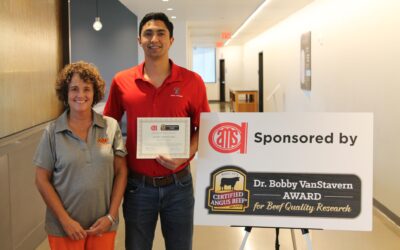
Looks can tell in beef cattle
Why some apples fall farther from the tree
By Miranda Reiman
“Boy, if he isn’t a spitting image of his grandpa!”
You’ve likely heard similar references before and they make this concept easy to grasp: Just like people,cattle don’t inherit genes equally.“
Because of random assortment and recombination, or crossover events during the sperm or egg cell formation, they can get an unequal proportion of genetic material from their grandparents,” says Bob Weaber, Kansas State University animal scientists.
Thus, an animal might favor its maternal grandfather and look nothing like the paternal one—which matters in cattle herds where sires vary greatly for economically important traits.
That’s just Mother Nature’s mechanism for maintaining genetic diversity in the population. “But from a geneticist’s perspective,” Weaber says, “we’re trying to figure out: Did they get a good assortment of genes or a bad assortment of genes from their parents?”
The question is especially relevant in explaining variation in composite cattle breeds and herds. More than a decade ago, Colorado State University professor Daryl Tatum noticed that variability when looking over the King Ranch’s Santa Gertrud is bulls.
“They all were the same percentage of Brahman and Shorthorn breeding, but there was everything from what looked like straight Shorthorn to ones that looked like a big, old red-colored Brahman,” he says. “If the genes segregated so differently in these populations to where they looked so much different, does it mean their meat quality was different as well?”
So, the curious meat scientist studied it.
Steers of known genotype, either a quarter Braham and three-quarters Hereford or half-and-half, were scored based on appearance to estimate their percentages of each breed.
“We had some all over the spectrum based on phenotype,” Tatum says. The breed estimates for quarter-blood Brahmans came in anywhere from no Brahman influence to 9/16. Looking at the half-bloods,estimates ranged from a quarter to 13/16 Brahman.
“They were highly variable in appearance and we found it was correlated with tenderness,” he says. “At the end of the day, cattle that looked more Brahman produced tougher steaks than the ones that looked like they had less Brahman in them, even though they might have been the same actual percentage.”
In steaks from cattle that appeared to have 1/8 or less Brahman breeding, the Warner-Bratzler shear-force value (the standard mechanical measure of tenderness) was 3.88. That’s compared to a less desirable 4.91 rating for those with more than 50% Brahman influence.
“We don’t have conclusive proof, but perhaps the cattle that looked less Brahman in phenotype actually have genes that are more like the other breed,” Tatum says.
Scientists are anxious to use DNA technology for additional research.
Weaber says variation in the progeny (F2) from two first-cross (F1) animals is more noticeable.

“Where it becomes more complicated is when you breed a hybrid to a hybrid,” he says. “Even though the F2s have half of their genetic material from each breed on average, some re-pairing of chromosomes from the same breed occurs.”
That explains why the heterosis advantage is diminished the second time around, though some will have more and others less than average. Using DNA to identify which ones were truly half-bloods with each chromosome in the pair coming from different breeds would help.
“You could do some pretty interesting things if you had those genotypes,” Weaber says. “You could optimize heterosis through different breeding structures.
”Of course, making sure the genes from both sides of the pedigree are superior is an insurance policy.
“You don’t dig yourself out of the hole just by crossbreeding,” he says. “The merits of the parents going into those systems are important,” especially for traits with moderate to high heritability where heterosis is low. “If you’ve got two parents that you put together, one excels and one does not, the rules of additive genetics suggest you’re likely going to produce an animal that’s somewhere near the middle.”
You may also like
Everything They Have
Progress is a necessity on the Guide Rock, Nebraska, ranch where Troy Anderson manages a commercial Angus herd, small grower yard, his 10-year-old son, and a testing environment. Troy’s approach includes respect for his livestock, people and land. For that, Anderson Cattle was honored with the CAB 2023 Commercial Commitment to Excellence Award.
Certified Angus Beef Recognizes Beef Quality Research
First-place honors go to Andres Mendizabal, an international student pursuing a Ph.D. in animal science at Texas Tech University. His research is titled, “The Accuracy of USDA Yield Grade and Beef Carcass Components as Predictors of Red Meat Yield.”
Progress, Not Perfection
It’s a labor of love, obvious in the way she lights up explaining their family’s 33-year effort to proactively adapt Angus cows to their land. A lifetime of telling stories from the pasture or kitchen has resonated with nonfarm consumers as much as fellow ranchers. “Everything we do is about cattle, but it’s also about family and connecting our kids to the land and to the cattle,” Debbie Lyons-Blythe says.



